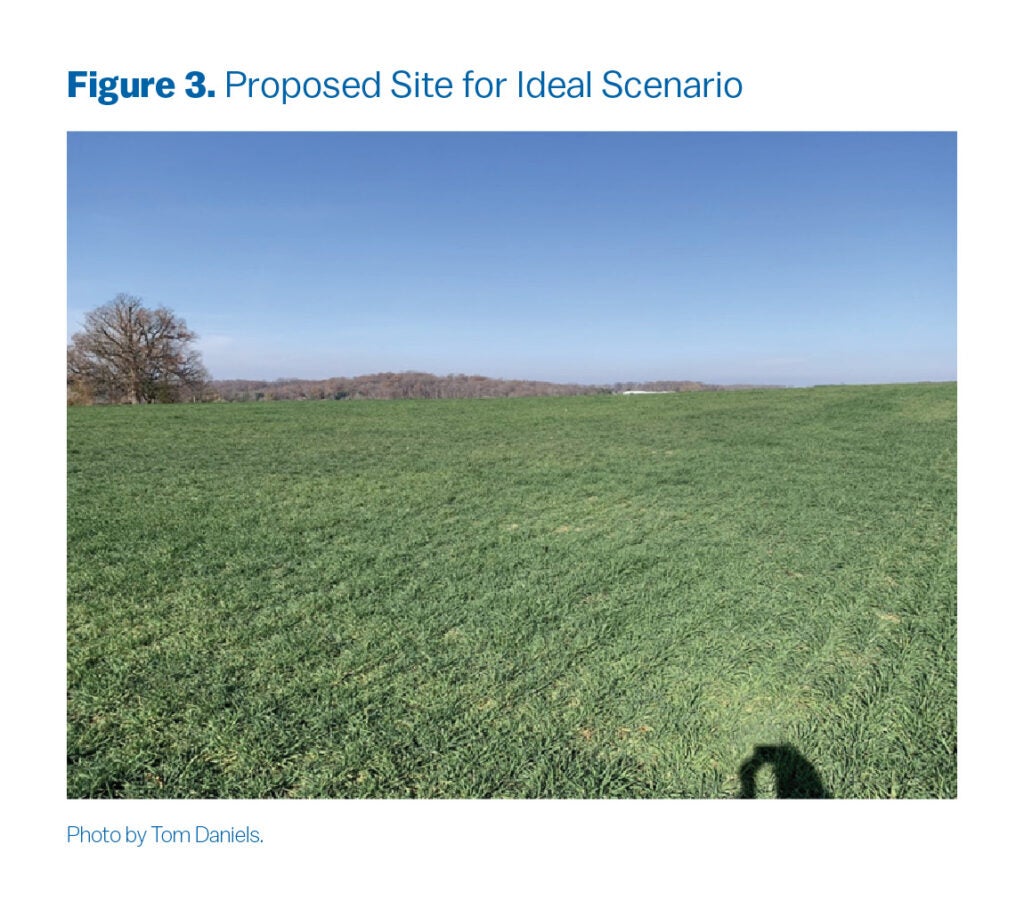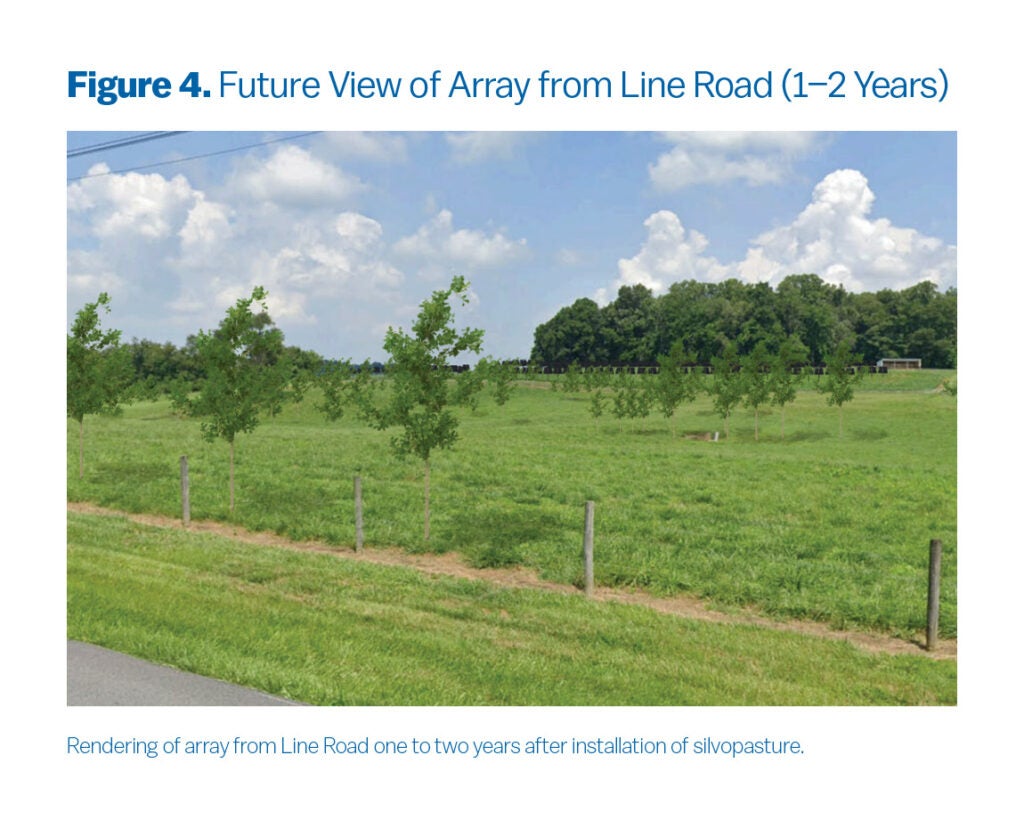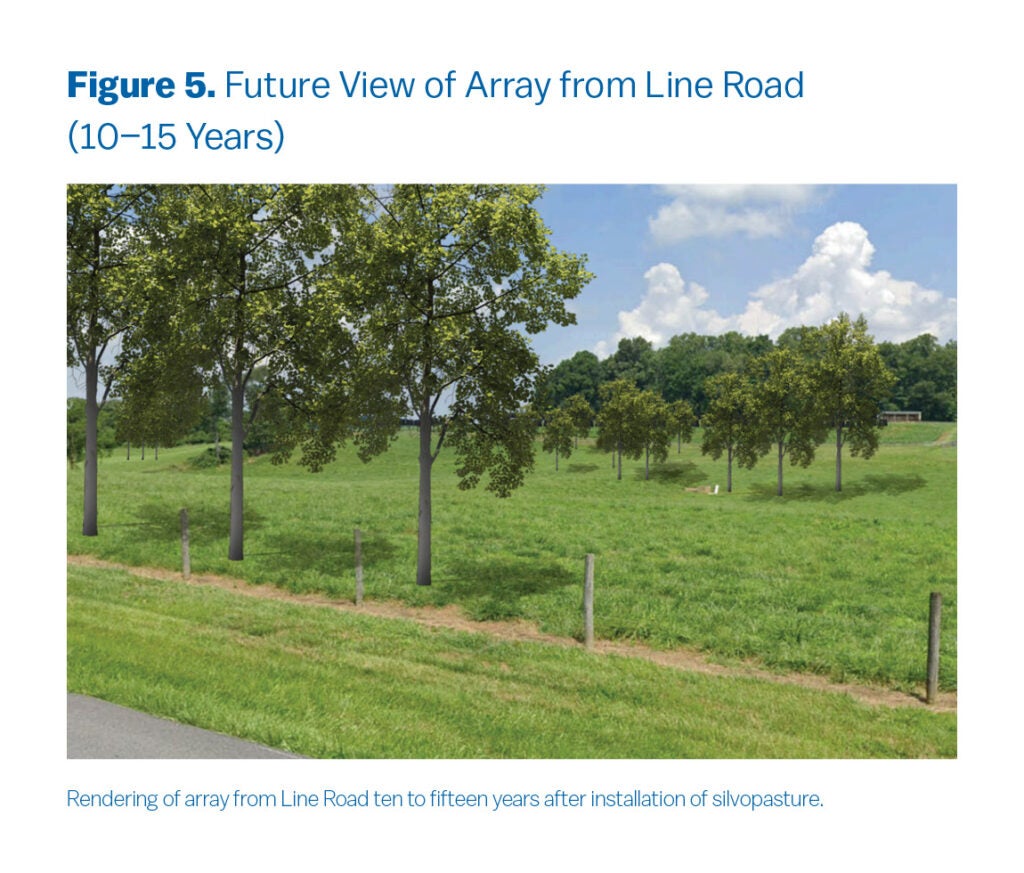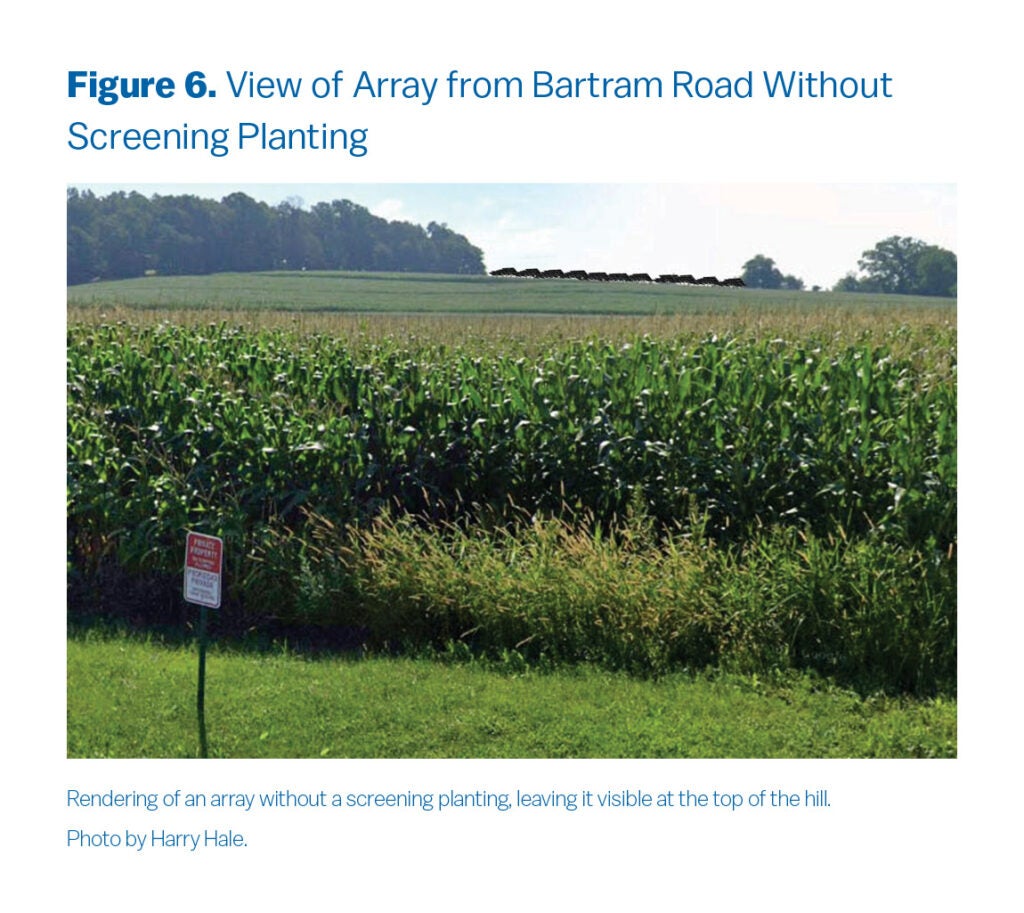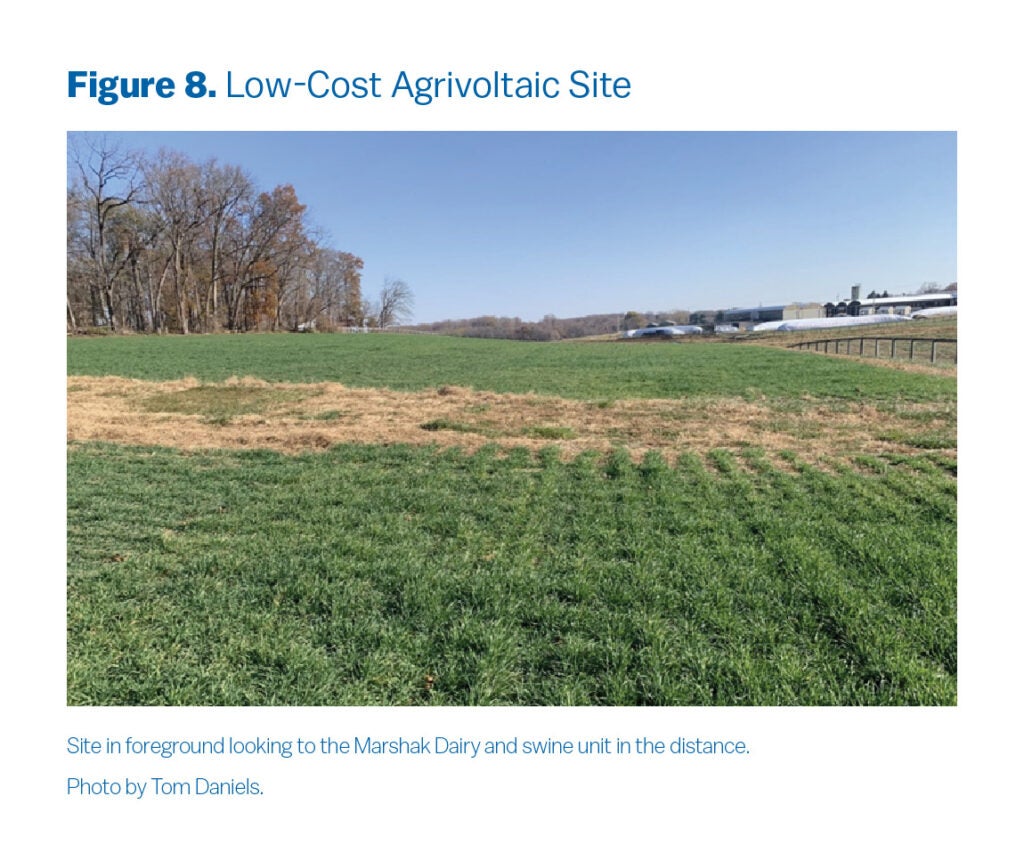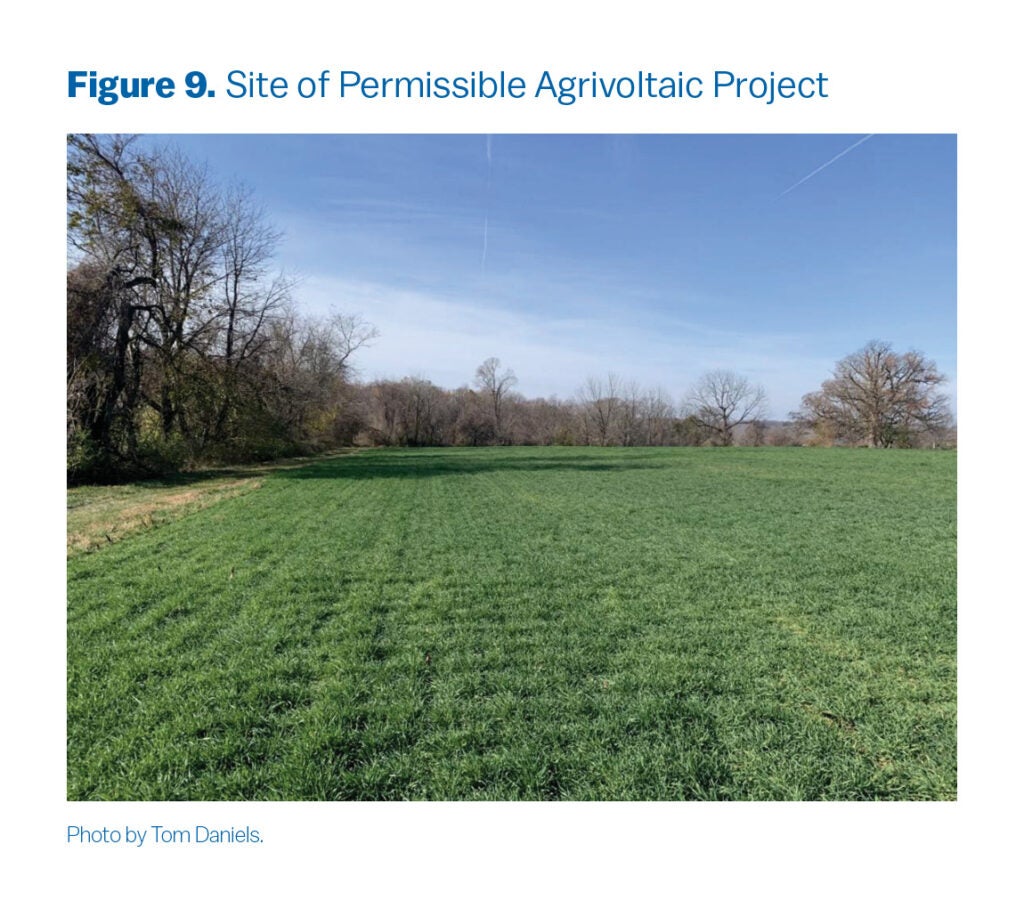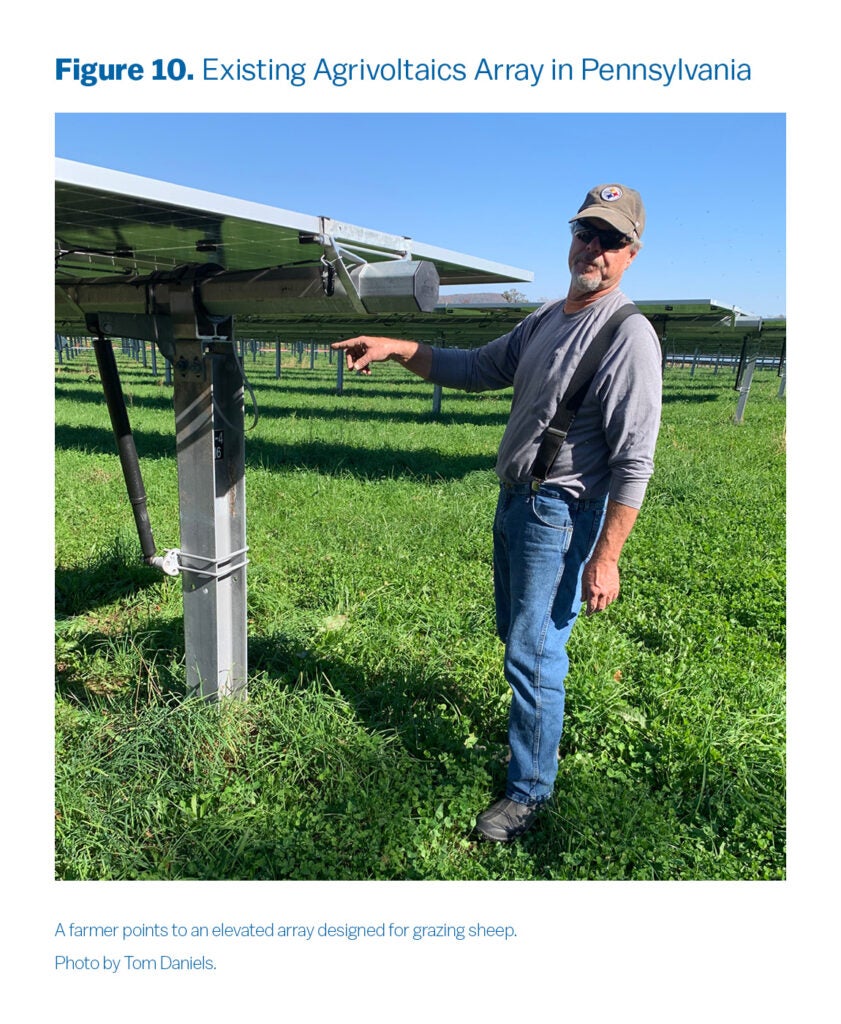Agrivoltaic Options and Designs at the New Bolton Center of the University of Pennsylvania Veterinary School
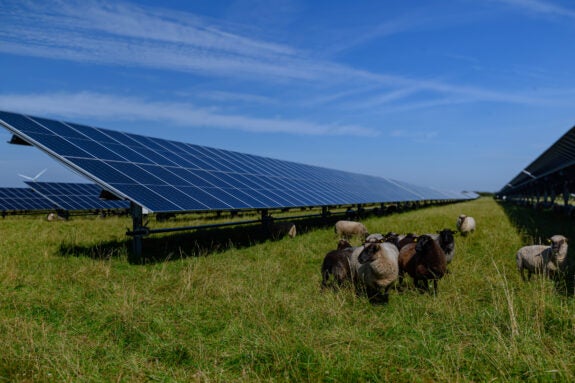
The Penn School of Veterinary Medicine is exploring the development of an agrivoltaics project combining sheep grazing for research with the production of solar electricity to help power the New Bolton Center. This digest looks at three options: ideal, low-cost, and zoning-constrained.
At A Glance
Key Challenge
The ideal agrivoltaics site lies in two townships, with zoning ordinances that tightly limit the area that can be developed for solar arrays. The current zoning precludes sheep as part of the project.
Policy Insight
To overcome the zoning obstacles, the Veterinary School could propose changes to the township zoning ordinances or obtain a variance from the zoning ordinances.
Introduction
Agrivoltaics combine ground-mounted solar panels to produce electricity with the raising of vegetables, berries, pollinator habitat, or livestock. The University of Pennsylvania School of Veterinary Medicine has expressed a strong interest in making the 700-acre New Bolton campus as energy self-sufficient as possible while minimizing greenhouse gas emissions.
One way to help reach this goal is the deployment of solar arrays to produce renewable electricity. Because the veterinary school conducts research on animals, the addition of sheep grazing—the most popular livestock for agrivoltaics—would add a new area of study. In addition, the agrivoltaic project at New Bolton can serve as a demonstration project for Pennsylvania farmers who are looking to add an agrivoltaics enterprise. So far, there are only a handful of agrivoltaics projects in Pennsylvania, reported as eight out of 599 agrivoltaic sites nationally (U.S. DOE 2024).
Agrivoltaic Project Design: Exploring Scenarios
The New Bolton site for agrivoltaics involves designs for three scaled scenarios:
- Ideal Scenario. The ideal size in megawatts and acres is based on the objective of supporting a certain number of sheep and providing enough electricity to more than power New Bolton’s Marshak Dairy and the swine unit.
- Low-Cost Scenario. A low-cost agrivoltaic project would combine some sheep grazing with half of the electricity used by the dairy and the swine unit.
- Permissible Scenario. Under the current zoning regulations of East Marlborough Township and West Marlborough Township, this project would dramatically limit solar array acreage and megawatts.
In this digest, we outline each scenario—including cost estimates for construction and maintenance.
There are two main designs for agrivoltaics: farming under the solar panels and farming between the solar panels. Farming between panels usually offers more space for crops and livestock. Sheep can benefit from slightly taller racking than the typical three feet off the ground, to enable them to graze underneath the panels as well as between rows of panels. Sheep can keep down grass and weeds, thus minimizing the need to mow. Also, sheep don’t climb on the panels, as goats would.
Agrivoltaics are more often found in conjunction with small-scale solar projects rather than utility-scale arrays that generate five or more megawatts and cover more than 25 acres (US DOE 2024). Agrivoltaics with sheep grazing can vary in size from a few acres and a capacity of less than one megawatt to large projects with more than 100 MW of generating capacity and thousands of sheep on hundreds to thousands of acres.
Goals of the Study
This study sought answers to several questions about the design of an agrivioltaic project at the New Bolton Center:
- What are the opportunities and obstacles for three agrivoltaics scenarios at New Bolton?
- What is the ideal size of an agrivoltaic project at New Bolton in acres and megawatts and what is the cost?
- What is the low-cost agrivoltiac scenario at New Bolton?
- What is the largest agrivoltaics project that could be built at New Bolton under the current local zoning regulations?
- How might we design the agrivoltaics site according to the three scenarios?
Opportunities and Obstacles for Three Scenarios
This study looked at three agrivoltaics scenarios at New Bolton in terms of acres, sheep numbers, solar electricity generation capacity, cost, and local government zoning restrictions. The scenarios vary from an ideal scenario to a low-cost scenario to the currently permissible scenario.
What is the ideal scenario? The ideal scenario for an agrivoltaic project at the New Bolton Center would provide more than enough electricity for the swine and Marshak Dairy units. This array would have a capacity of about 1 MW and cover about 3.5 acres. This would also provide grazing space under and between the solar panels for 27 sheep, although additional pasture would be needed to support the sheep.
The estimated gross cost of the ideal agrivoltaic design is $2.8 million to $4.6 million and would generate a total of 370 MWh annually. This scenario is currently not permitted by the East and West Marlborough Township zoning ordinances.
What is the low-cost scenario? If a 1 MW array is considered too expensive, a second agrivoltaics scenario is a lower cost solar array with a capacity of about 450 kW. This would provide half of the electricity needed by the swine and Marshak Dairy units at New Bolton. This scenario would cover about 1.5 acres and provide grazing space for 11 sheep.
The estimated gross cost of the low-cost agrivoltaics design is $1.2 million to $1.9 million and would generate 154 MWh annually. This scenario is also not currently permitted by the East and West Marlborough Township zoning ordinances.
What is the largest agrivoltaics project currently allowed? The third agrivoltaic scenario presents the largest agrivoltaic project that could be built given the size limits for ground-mounted solar arrays in the East and West Marlborough Township zoning ordinances. This array would have a capacity of only 17.5 kW and cover just 860 square feet. A project of this size would not provide sufficient grazing space for any sheep.
The estimated gross cost of this design is $45,000 to $74,000 and would generate 6 MWh annually, providing just under 2% of the electricity for the swine and Marshak Dairy units.
Cost Considerations. The ideal scenario agrivoltaics array would require 1,732 solar panels (Qcells Q.Tron XL-G2.3/BFG 635W) and require 9 AC/DC inverters (CPS SCH100KTL-DO/Us-480) (Meadow Valley Electric Solar 2024).
The lower cost scenario would require 718 solar panels (Qcells Q.Tron XL-G2.3/BFG 635W) and require 4 AC/DC inverters (CPS SCH100KTL-DO/Us-480) (Meadow Valley Electric Solar 2024).
The scenario currently allowed would require 28 solar panels (Qcells Q.Tron XL-G2.3/BFG 635W) and require 1 AC/DC inverter (CPS SCH100KTL-DO/Us-480).
Costs for photovoltaic panel arrays are determined on a cost per watt basis ($/W) (NREL 2023). The National Renewable Energy Laboratory at the U.S. Department of Energy states that a typical “utility scale” array in 2023 cost $1.20/W, down from $6.50/W in 2011 (NREL 2023). The arrays at New Bolton would have an estimated cost of about $2/W, without any grants or tax incentives.
The true cost per watt may be even slightly higher because of additional steel and other materials and labor needed to make a solar array compatible with grazing operations. Agrivoltaics with sheep or cows typically require taller racking for the solar panels than the three feet above ground racking for vegetables, berries, or pollinator habitat.
NREL also notes that hard costs (panels, mounts, and inverters) should account for 60% of the total cost of the installation price, while soft costs (labor, grid connection, land acquisition) should account for the other 40% (2023).
For the agrivoltaics arrays at New Bolton Center, the estimated split between hard costs and soft costs is 50:50 because of the need for labor to install screening plantings to preserve the aesthetic value of the site, and additional labor required to install taller racking for the panels that enable livestock to graze underneath.
Grants and incentives. When this study was launched in 2024, there were grants and incentives to help recover more than 75% of upfront costs. The USDA Rural Energy for America Program (REAP) would fund up to 50% and the Inflation Reduction Act of 2022 investment tax credit could help recover up to 30% of total costs, the Penn Vet School might have been eligible to use the Modified Accelerated Cost Recovery System (MACRS) to defray an additional 25% of the total cost.
If these grants and incentives were maximized, the net cost of the 1 MW array would be between $420,000 and $688,000, the net cost of the 450 kW array would be between $174,000 and $285,000, and the net cost of the 17.5 kW array would be between $6,700 and $11,200 (Schwabe, NREL, 2019). However, under the second Trump administration, US Department of Agriculture REAP grants for solar projects on primate farmland have been eliminated and tax incentives for commercial solar development are slated to disappear at the end of 2027. .
Savings on electricity consumption. The strongest argument for installing an agrivoltaics array is the benefit derived from saving on electricity expenses over the long term (30 years). The Marshak Dairy and the swine unit use 314 MWh of electricity annually which costs $26,412 at a rate of $0.0839 per kWh.
If the cost of electricity rises by roughly 3% annually, 314 MWh of electricity will cost over $62,000 in 2055 (USBLS 2025). If the average degradation in efficiency for a typical solar array is 1% or less annually, after 30 years of use an array will likely be operating at about 75% efficiency of that the year of installation (Jordan and Kurtz 2013).
This means that in year 2055 the 1 MW array would eliminate over $54,000 in electricity costs at New Bolton Center. In a 30-year period, the array would eliminate over $1.2 million in electricity costs. The 450 kW array would eliminate over $520,000 in electricity costs over a 30-year period. And the 17.5 kW array would eliminate over $20,000 in electricity costs over a 30-year period.
If federal grants and investment tax credits were available, the ideal 1 MW array would more than pay for itself over 30 years, given the savings on electricity costs. The same is true of the low-cost 450kw array, though the electricity savings would be lower. The current largest allowed 17.5 kw array would about break even.
How to Design the Agrivoltaics Site According to the Three Scenarios?
The site of the ideal agrivoltaic project is shown in Figure 1 and Figure 3. A common obstacle to local government approval of solar projects is their appearance on the rural landscape. Because solar sites can change the aesthetics and character of rural areas, the ideal project would be designed with silvopasture screening of the solar array to minimize views of the array from nearby roads and properties (see Figures 2–7). The trees would likely be white pines or Arborvitae.
The site for the low-cost scenario is shown on Figure 8. The site for the solar array under current local zoning is shown in Figure 9. A comparison of the sites of the three scenarios is presented in Figure 11. Figure 10 shows the higher racking of solar panels to enable sheep to graze underneath. Figure 12 depicts the design of a solar array to minimize the shading of arrays in electricity production.
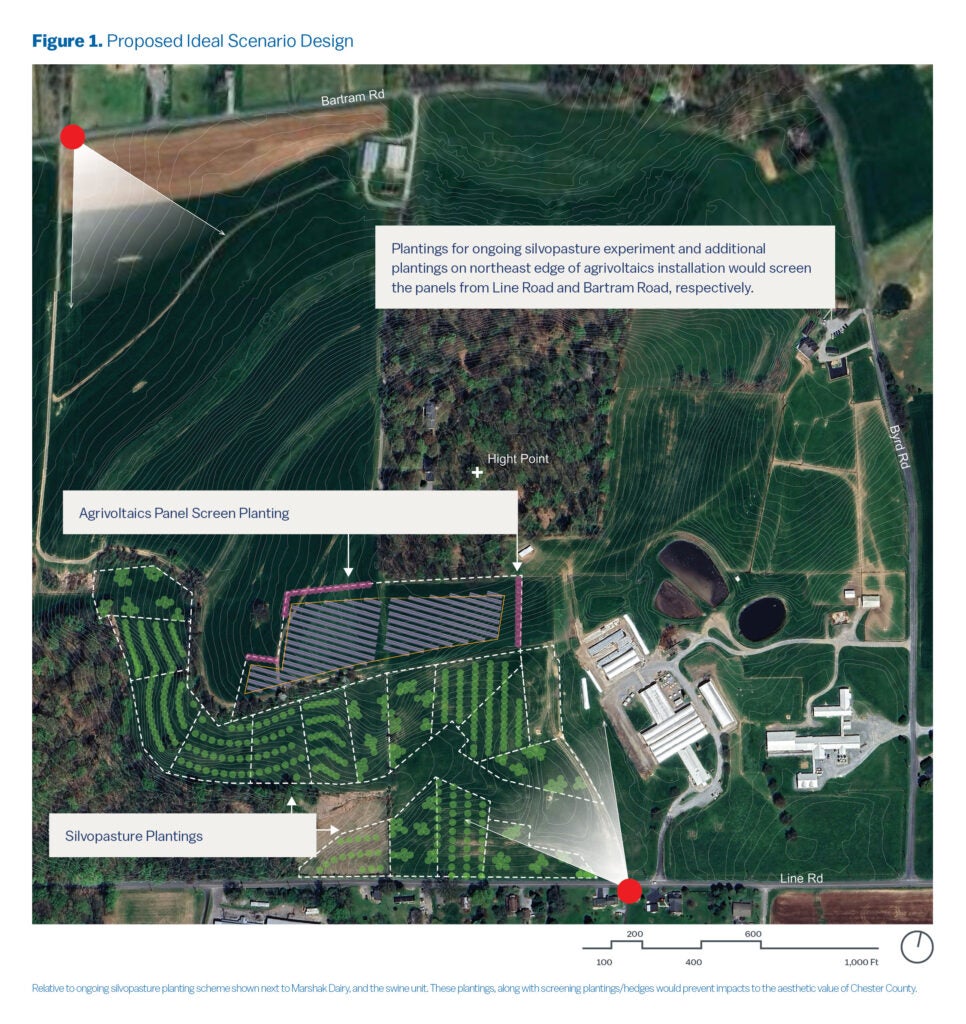

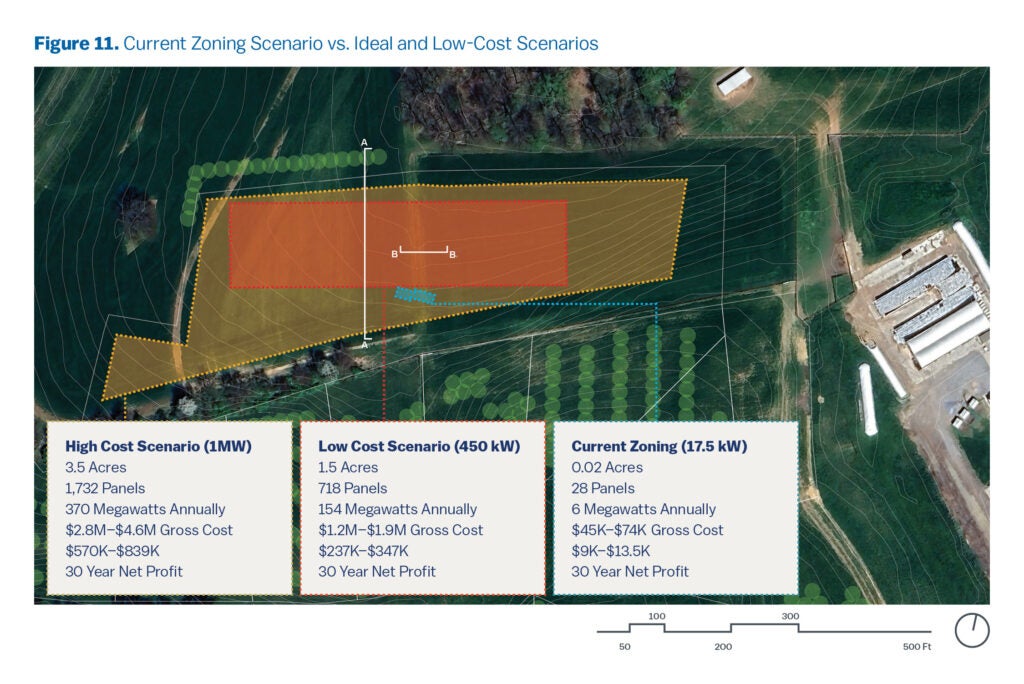
These plans, sections, renderings, and photos address the practical concerns of the proposed agrivoltaics array. Maintaining the aesthetic character of the landscape is a top concern. For this reason, we have been careful to specify the need for screening from adjacent roadways to prevent drastic alterations to the visual appeal of the landscape to residents.
The existing silvopasture project that is taking place adjacent to the ideal agrivoltaic site will also help prevent direct views of the solar panels from roadways and nearby properties (see Figure 7). Furthermore, there is potential for the grazing in the proposed array to be integrated into the existing rotational grazing regime that is part of the silvopasture project. It should be noted that this design would almost certainly bring costs to the higher end of the proposed scale as it would require more steel for taller mountings for the panels (see Figure 11).
The heights and spacing of the proposed arrays would be standard for sheep across all three scenarios (1 MW, 450 kW, and 17.5 kW), the primary determinants of these factors being the height of the animals and the efficiency of the array. For sheep, a racking height of 7 feet for a centrally mounted set of double panels in rows angled at 31.5 degrees would provide a space of 4 feet beneath for passage of livestock (see Figure 12).
This distance also prevents any instance of self-shading in the array, even when the sun is at its lowest altitude relative to the array. The dimensions of the solar panels are 96.9 inches by 44.6 inches making the length of the face of 2 mounted panels oriented lengthwise just over 16 feet. The height of the panels mounted at 31.5 degrees in the array would be 11.5 feet for sheep.
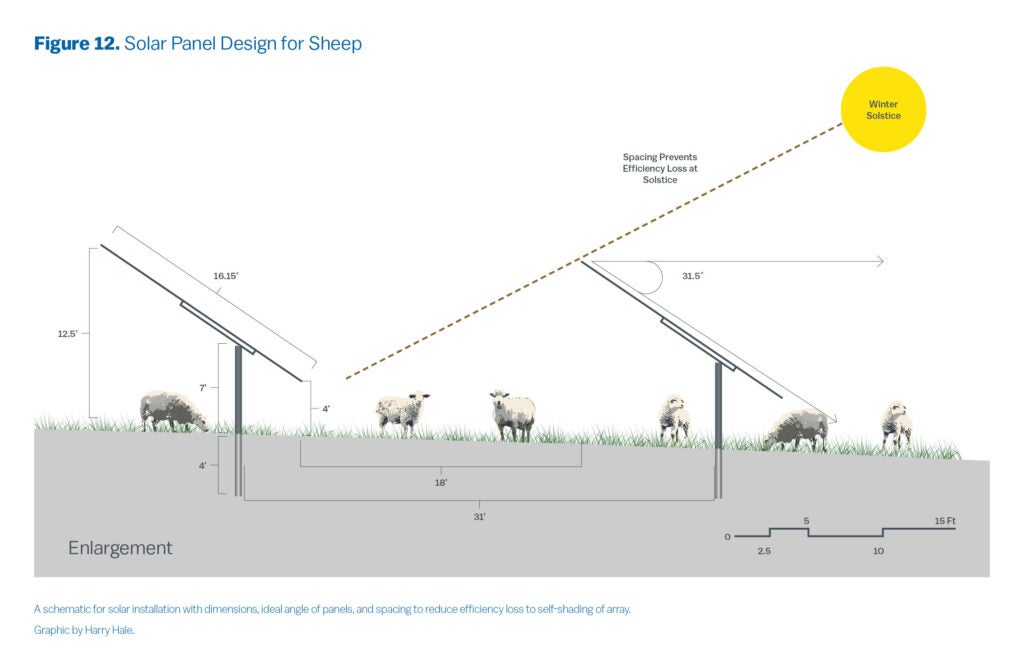
Species chosen for screening plantings should be edible for the sheep that graze in the array, or at least non-aggressive so that they do not spread inside or around the array. The land that will be used for the array and the surrounding area is currently used to grow corn for feed. The corn field runs up to Bartram Road, as is visible in figures 5 and 6. These areas are planted with a cover crop in the winter as visible in figures 7, 8, and 9. Disruption to this field other than the agrivoltaic array should be minimized.
Conclusions and Recommendations
The New Bolton Center has adequate space to develop an agrivoltaic project that could support a flock of sheep for research studies and a significant amount of renewable solar electricity to power at least parts of the center.
Two main obstacles exist:
- The best site for an agrivoltaics project lies in two townships, East and West Marlborough, both of which have zoning ordinances with tight limitations on the amount of land that can be developed for ground-mounted solar arrays. The zoning restrictions in effect preclude the use of sheep grazing in an agrivoltaics project.
- The cost is potentially substantial for developing either an ideal size agrivoltaics project to fully power the Marshak Dairy and the swine unit or an agrivoltaic project that could power half the Marshak Dairy and the swine unit. Federal funding and incentives for an agrivoltaics project are being eliminated under the current administration.
The only way to overcome the zoning obstacle is to propose changes to the township zoning ordinances or obtain a variance from the zoning ordinances.
As for funding challenges, other sources may include a grant from the Pennsylvania Department of Agriculture, donations from veterinary school alumni, and donations from friends of the New Bolton Center.
Tom Daniels
Crossways Professor, City and Regional PlanningTom Daniels is the Crossways Professor of city and regional planning at the Weitzman School. Daniels directs the concentration in Land Use and Environmental Planning.
Harry Hale
Landscape Architecture, Weitzman SchoolHarry Hale is a recent graduate of the University of Pennsylvania where he earned a master of landscape architecture degree at the Weitzman School.
Jordan, D. and S. Kurtz. 2013. “Photovoltaic Degradation Rates—An Analytical Review.” Progress in Photovoltaics: Research and Applications. 21. 10.1002/pip.1182. https://www.nrel.gov/docs/fy12osti/51664.pdf
National Renewable Energy Laboratory. U.S. Department of Energy. 2023. “Solar Installed System Analysis.” https://www.nrel.gov/solar/market-research-analysis/solar-installed-system-cost.html
Schwabe, Paul. 2019. “Minnesota On Site Solar Procurement Workshop.” NREL. https://www.epa.gov/sites/default/files/2020-06/documents/4.0-financing-options-for-solar-projects.pdf
U.S. Bureau of Labor Statistics. 2025. “Average Energy Prices, Philadelphia-Camden-Wilmington – November 2024.” https://www.bls.gov/regions/mid-atlantic/news-release/averageenergyprices_philadelphia.htm
U.S. Department of Energy. 2024. “Inspire: Agrivoltaics Map.” https://openei.org/wiki/InSPIRE/Agrivoltaics_Map.
